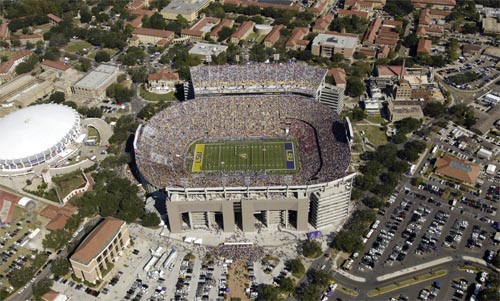Home > About Us > West Coast Turf in the News
Tiger Stadium

Louisiana State University is serious about sports. Their football team has won three national titles, including the 2007 BCS National Championship. Their baseball team has won the College World Series five times. So when it came time to replace the Tiger Stadium football field and build the new Alex Box Stadium baseball field this year, they had to make sure they found a turf worthy of the Fighting Tigers. Bull's-Eye Bermuda got the nod.
The football field was first on the agenda. Tiger Stadium has been called the most "feared road playing site in America" due to the home team winning record. Todd Jeansonne, assistant director of athletic facilities for LSU, was familiar with Bull's-Eye Bermuda (aka MSB-30/Mississippi Choice), and insisted on it for the new field.
"Mississippi State had Bull's-Eye on their field and that right there is a great referral. I tried it on some practice fields after I saw it," Jeansonne said. "I am always looking for 'cutting edge' technology with turf in the industry, and I found that with Bull's-Eye."
Bull-Eye Bermuda was actually developed at Mississippi State by Drs. Jeff Krans and Wayne Philly. According to Krans, the plant's broad leaves and tightly closed canopy create a dense biomass, resulting in a "cushion of grass" so football players are running on top of the grass rather than through it. "It gives better traction for the players and less wear on the field," said Krans. "Also, the color is a deep, dark green, which is most desirable on athletic fields."
The turf density is what made Jeansonne a fan. "One of the best elements I found with this variety is that you play the game 'on' the grass and not 'in' the grass. Its vigorous growth pattern and plentiful stolons provides great footing for the athletes--they are always happy about that," he noted.
The grass variety was chosen, but now they had to find it. When selecting turfgrass, purity is extremely important. Jeansonne had known about West Coast Turf, and decided to check out their facility for himself. "I flew out West, and I liked what I saw. The entire farm was well maintained with lots of attention to detail. It was the quality of the grass out there that sealed the deal."
Because they had plenty of time for grow-in, Jeansonne chose to sprig the field. In mid-May, 2008, 1300 US Standard Bushels of Bull's-Eye were shipped from West Coast Turf's Scottsdale, Arizona, farm to Baton Rouge, LA, and mechanically planted at double the normal rate.
How is the new field holding up in its first season? "It's only 4-5 months old, and I have to keep reminding myself of that. It showed some wear from use near the end, but a young field is going to show the wear more than a mature field," Jeansonne explained. "It's going to only be better next year."
Alex Box Stadium was the next order of business. A new ballpark was needed to accommodate the growing crowds and facilitate the state-of-the-art amenities necessary to continue the baseball team's winning tradition. They built the new stadium just south of the old one, and it will debut with the '09 season.
Bull's-Eye Bermuda has a good reputation in ballparks and stadiums. The San Diego Padres have had it since the 2004 inauguration of PETCO Park, and the Arizona Diamondbacks just played their 9th consecutive year on Bull's-Eye at Chase Field. The Rose Bowl and Kauffman Stadium have had success with the grass as well.
Grant Trenbeath, head groundskeeper for the D-backs, has a unique circumstance at Chase Field, as the ballpark is covered by a retractable dome resulting in a great deal of shade. "Bull's-Eye has been the backbone of our field all of these years mostly because it performs better in shade," said Trenbeath. "We tried other grasses, but this one is by far the best for our low light situation."
Jeansonne has sunlight issues as well. "We have an enormous roof over the stands which can sometimes make it tough to grow grass. One of the reasons I put in Bull's-Eye at the ballpark is because of the good shade tolerance. But I also used it for a lot of the same reasons I put it on the football field-growth habit, abundant stolons, and impressive footing," he said.
After a total of six weeks of delays caused by two hurricanes, the baseball field was finally put down in early October. The decision was made to use sod instead of sprigs due to the timing. 103,000 sq. ft. of washed sod was shipped from West Coast Turf's Scottsdale farm to Baton Rouge, and rolls were cut 3.5 feet wide and 30 feet long. Because the sod was soil free, each refrigerated truckload contained up to 16,000 sq. ft., making the nearly 1500 mile drive an economically feasible option. The temperature was kept at 44 degrees F.
"I saw the turf when the trucks rolled in," said West Coast Turf spokesperson, John Marman. "It arrived with minimal shocking and had excellent sod strength when it was installed. It was rooting in just 2 days."
The playing field contractor, Munie Green Care, applied "VermaPlex" (an all natural microbial soil amendment) to the sod as each truckload was delivered, and daily at a rate of 2 oz./1000 sq. ft. Root growth within seven days of installation reached 3".
"By the end of October I had roots up to 7 inches out there," Jeansonne said.
"I'm very happy with how both fields have turned out," he continued. "Without a doubt I know we made the right choice going with Bull's-Eye."

